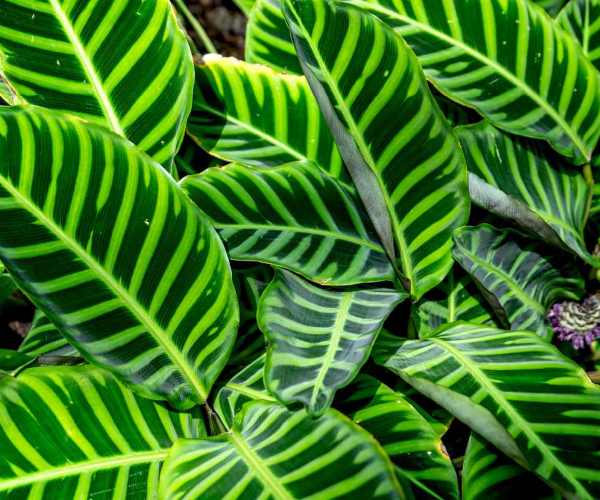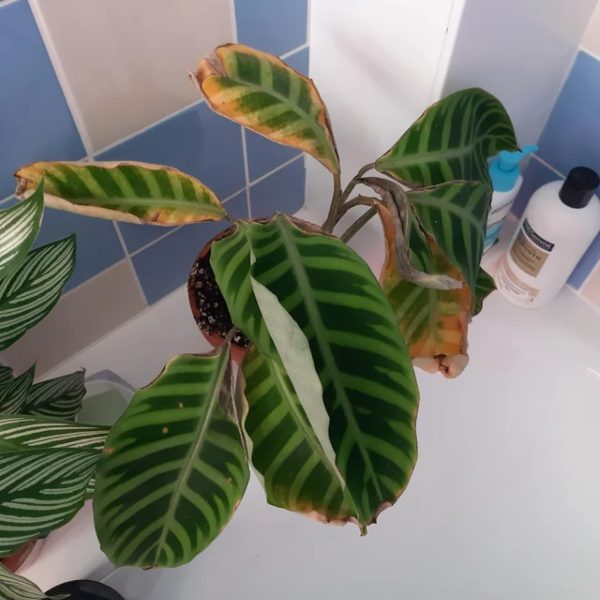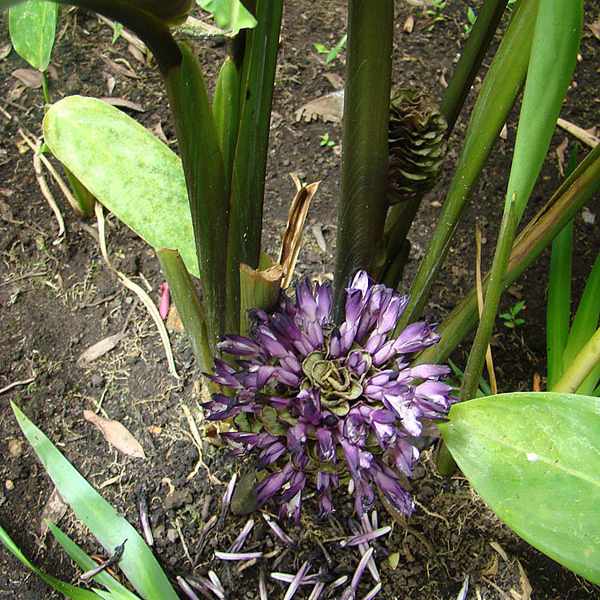Calathea zebrina also commonly known as the zebra plant is popular for their uniquely striped foliage. Just like its popular cousin the prayer plant, the zebra plant has leaves bright green with dark green stripes. Both plants have bright green leaves with dark green stripes. They are known to fold their leaves at night. The Zebra plant can grow up to three feet tall, with their leaves reaching two feet long.
- Botanical Name: Calathea zebrina
- Family: Marantaceae
- Plant Type: Perennial
- Mature size: 3 ft. tall, 2-3 ft. wide
- Sun Exposure: Partial
- Soil Type: Loamy, moist but well-drained
- Soil pH: Acidic, neutral
- Bloom Time: Spring
- Flower Color: Purple, White
- Hardiness Zones: 10-11, USA
- Native Area: South America
Also, Read Transform Your Bathroom With These 12 Plants
How to care for the calathea zebrina?
Here are the main caring tips for calathea zebrina:
- Pick loamy, well-draining soil when potting this plant.
- Keep this plant in a place that receives bright, indirect light.

- Check the soil and water the plant regularly when the top one to two inches of the soil starts to dry.
- Only fertilize when the growth is stunted.
Light
The zebra plant is native to South America and grows under the protection of tropical plants and other large trees. That is why it is accustomed to have filtered, dappled light. Do not keep this plant in direct light as the harsh sunlight can burn the leaves. If you’re keeping it outdoors, place it in partial sunlight, ideally dappled or filtered by other companion plants.
Indoors, choose a place near a bright window, but not where it gets direct light. A small table or a shelf is better for a zebra plant than a sunny window.
Soil
Zebra plant needs regular watering and watering depends on how fast the soil starts drying. Watering also changes depending on the season, climate, and humidity levels. Normally, these plants require watering once a week during their growing season. During winter, it should be less than once a week. The best way to check moisture level is to feel the soil. If the first one to two inches begins to feel dry, it is time to water.
Temperature and Humidity
Zebra plants need proper humidity to have better health and longevity. They require humidity at greater than 50 percent and ideally above 60 percent. If kept outside, it is easier to maintain that. For indoor zebra plants, you may require a humidifier to increase moisture in the air. If that isn’t available, you can keep the plant on a tray of pebbles and water or mist the leaves a couple of times a week.

Like many other plants in the Calathea genus, these zebra plants need warm temperatures to flourish. They thrive between 65 and 75 degrees Fahrenheit and they shouldn’t be kept in temperatures less than 50 degrees Fahrenheit.
Water
Zebra plants love moist soil. But keep in mind that overwatering the plant can cause the leaves to wilt. We recommend that you water your zebra plant to saturation every few weeks or as you notice the soil drying out. It allows the water to penetrate completely the soil until it comes out of the pot’s drainage hole.
Fertilizer
Zebra plants do not need much fertilizers. Frequent fertilizing can burn this plant. If you have a slow-growing or weak-looking plant, fertilize only during the growing season with a mild, well-balanced formula fertilizer diluted to a quarter strength.
How to propagate Calathea Zebrina
You can propagate Zebra plants by division. If your plant has become big enough to produce separate rosettes of leaves at its base, that is the perfect time to divide it. You require a container with good drainage, well-draining soil, and a pair of sharp snips or a knife. Then do the following:
- Fill the pot with moist, well-draining soil.
- Gently put your zebra plant out of its original pot and dust off excess dirt.
- Separate the rosettes of leaves using a knife or snips to cut through root systems when required.

- Keep each division in its pot so that the leaves rest at its soil level. After that, cover the roots completely with soil and water the plants thoroughly. Put them in an area with bright, indirect light and high humidity.
Common problems with Calathea Zebrina
Zebra plants become hardy, healthy, and tropical houseplants if provided with the right conditions. Problems can occur when there are maintenance errors. Here are some common issues with this plant:
Brown, curling leaf tips
This is a big sign of a lack of humidity or water. If the leaves start curling or turning brown, you have to raise humidity by placing a humidifier near the plant. You can also place the pot on a tray of water and pebbles or mist the plant regularly.

If the plant needs to be dry, water it thoroughly until all the water is drained and the soil is moistened. To improve the plant’s appearance, you can use sterile scissors to trim the brown edges.
Drooping, mushy stems
If your zebra plants’ stems feel mushy or soft or the whole foliage starts drooping excessively, it is the result of overwatering. If that continues, it can quickly turn into root rot. You have to take necessary action to prevent the root rot from spreading and save your zebra plant.
Types of Zebra Plant
- A. squarrosa ‘Dania’: This plant has green leaves with white veins and sports reddish to maroon stems and produces yellow flowers.
- A. squarrosa ‘Fritz Prinsler’: This has green leaves with slightly yellow veins. Its flowers and bracts are a yellow color.
- A. squarrosa ‘Leopoldii’: Its leaves are broader and blooms gold flowers with red bracts.
- A. squarrosa ‘Louisae’: This plant has green leaves with yellow veins and yellow flowers with gold bracts.
- A. squarrosa ‘Snow White’: This has a darker green leaf with white veins but is a bit unique with the tiny white spots on the leaf that look like snow. The flowers are yellow or gold.
Potting and repotting zebra plant
Zebra plants do not need to be repotted often other than repotting propagated shoots. This benefits from a new home only every two to three years. If you find that the plant’s soil has gotten lower, simply remove the top inch or two of soil with a fresh mix, which will provide the plant with an extra dose of nutrients.
Common pests
While the zebra plant is unusual, it still might get infected by common bugs like, aphids, mealybugs, mites, scale, and thrips. These pests can be eliminated with insecticidal soap or by specific remedies recommended for each insect.
How to get your zebra plant to bloom?
Zebra plants are very finicky when it comes to blooming. So, getting it to bloom is a tricky task in itself.
Bloom months
They usually bloom in late summer or early fall. Indoors, it may alter its natural schedule.
How long does a zebra plant bloom?
If you’re lucky enough to manage to get your zebra plant to flower, the bloom can last up to six weeks.

What does a zebra plant look and smell like?
A blooming zebra plant will have a central spike of small, tubular flowers that are bright yellow and stand out among the beautiful striped green leaves. They might give a hint of sweet fragrance at first but are normally not pungent.
FAQs
Q: Is the Zebra plant easy to care for?
A: Like many warmth-loving plants, the zebra plant can face challenges when grown indoors, especially in temperate areas. It needs a lot of moisture, warmth, and food to grow and thrive, and these conditions are naturally not conducive to the plant when grown indoors.
Q: How fast does a zebra plant grow?
A: It’s a very slow-growing plant, reaching its full height of just a couple of feet in three years. You’ll rarely need to repot your plant.
Q: How long can a zebra plant live?
A: With the right care and attention, a zebra houseplant can potentially live for up to a decade.
Q: Are zebra plants and Calathea zebrina related?
A: Both plants go by the common name of zebra plant, yet these two plants aren’t related. The main difference is that the Calathea zebrina has lighter-colored leaves and it doesn’t flower like the Aphelandrosa squarrosa.
Also, Read All You Need To Know About Polka Dot Plants: Growth, Care, Tips, and More
